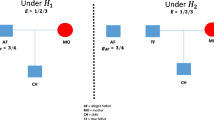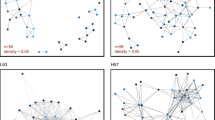Abstract
Allelic dropout in relationship problems may commonly appear in areas such as disaster victim identification and the identification of missing persons. If dropout is not accounted for, the results may be incorrect interpretation of profiles, loss of valuable information and biased results. In this paper, we explore different models for dropout in kinship cases and present an efficient implementation for one of the models. The implementation allows for dropout to be handled simultaneously with phenomena like silent alleles and mutations that may also cause discordances in relationship data, in addition to subpopulation correction. The implemented dropout model is freely available in the new version of the Familias software. The concepts and methods are illustrated on real and simulated data.












Similar content being viewed by others
References
Anderung C, Persson P, Bouwman A, Elburg R, Goethertroem A (2008) Fishing for ancient DNA. Forensic Sci Int Genetics 2(2):104–107. doi:10.1016/j.fsigen.2007.09.004
Balding DJ (2013) Evaluation of mixed-source, low-template DNA profiles in forensic science , Proceedings of the National Academy of Sciences of the United States of America, vol 110(30), pp 12241–12246, DOI http://10.1073/pnas.1219739110
Brenner C, Weir B (2003) Issues and strategies in the DNA identification of world trade center victims. Theor Popul Biol 63(3):173–178. doi:10.1016/S0040-5809(03)00008-X
Buckleton J, Triggs C (2006) Dealing with allelic dropout when reporting the evidential value in DNA relatedness analysis. Forensic Sci Int Genetics 160(2-3):134–139. doi:10.1016/j.forsciint.2005.08.023
Curran J, Gill P, Bill M (2005) Interpretation of repeat measurement DNA evidence allowing for multiple contributors and population substructure. Forensic Science International 148(1):47–53. doi:10.1016/j.forsciint.2004.04.077
Egeland T, Mostad P, Mevag B, Stenersen M (2000) Beyond traditional paternity and identification cases. Selecting the most probable pedigree. Forensic Sci Int Genetics 110(1):47–59. doi:10.1016/S0379-0738(00)00147-X
Gill P, Gusmão L, Haned H, Mayr W, Morling N, Parson W, Prieto L, Prinz M, Schneider H, Schneider P, Weir B (2012) DNA commission of the International Society of Forensic Genetics: Recommendations on the evaluation of STR typing results that may include drop-out and/or drop-in using probabilistic methods. Forensic Sci Int Genetics 6(6):679–688. doi:10.1016/j.fsigen.2012.06.002
Haned H (2011) Forensim: An open-source initiative for the evaluation of statistical methods in forensic genetics. Forensic Sci Int Genetics 5(4):265–268. doi:10.1016/j.fsigen.2010.03.017.
Kling D, Tilmar A, Egeland T (2014) Familias 3-extensions and new funcionality. Forensic Sci Int Genetics. doi:10.1016/j.fsigen.2014.07.004
Mitchell AA, Tamariz J, O’Connell K, Ducasse N, Prinz M, Caragine T (2011) Likelihood ratio statistics for DNA mixtures allowing for drop-out and drop-in. Forensic Sci Int Genetics Supplement Series 3(1):240–241. doi:10.1016/j.fsigss.2011.08.119
Mulero JJ, Chang CW, Lagace RE, Wang DY, Bas JL, McMahon TP, Hennessy LK (2008) Development and validation of the AmpFlSTR (R) MiniFiler (TM) PCR amplification kit: A MiniSTR multiplex for the analysis of degraded and/or PCR inhibited DNA. J Forensic Sci 53(4):838–852. doi:10.1111/j.1556-4029.2008.00760.x
Rohland N, Hofreiter M (2007) Comparison and optimization of ancient DNA extraction. Biotechniques 42(3):343–352. doi:10.2144/000112383
Slooten KJ (2011) Validation of DNA-based identification software by computation of pedigree likelihood ratios. Forensic Sci Int: Genetics 5(4):308–315. doi:10.1016/j.fsigen.2010.06.005
Sprecher CJ, McLaren RS, Rabbach D, Krenke B, Ensenberger MG, Fulmer PM, Downey L, McCombs E, Storts DR (2009) Powerplex®;ESX and ESI systems: a suite of new STR systems designed to meet the changing needs of the DNA-typing community. Forensic Sci Int: Genetics Supplement Series 2(1):2–4. doi:10.1016/j.fsigss.2009.08.058
Tvedebrink T, Eriksen PS, Mogensen HS, Morling N (2009) Estimating the probability of allelic drop-out of STR alleles in forensic genetics. Forensic Sci Int Genetics 3(4):222–226. doi:10.1016/j.fsigen.2009.02.002
Tvedebrink T, Eriksen PS, Asplund M, Mogensen HS, Morling N (2012) Allelic drop-out probabilities estimated by logistic regression—further considerations and practical implementation. Forensic Sci Int Genetics 6(2):263–267. doi:10.1016/j.fsigen.2011.06.004.
van Dongen CB, Slooten K, Burgers W, Wiegerinck W (2009) Bayesian networks for victim identification on the basis of DNA profiles. Forensic Sci Int Genetics Supplement Series 2(1):466–468. doi:10.1016/j.fsigss.2009.08.024.
van Dongen CB, Slooten K, Slagter M, Burgers W, Wiegerinck W (2011) Bonaparte: application of new software for missing persons program. Forensic Sci Int: Genetics Supplement Series 3(1):119–120. doi:10.1016/j.fsigss.2011.08.059.
Weir BS, Anderson AD, Hepler AB (2006) Genetic relatedness analysis: modern data and new challenges. Nat Rev Genet 7(10):771–780. doi:10.1038/nrg1960
Acknowledgments
GD and TE have received funding support from the European Union Seventh Framework Programme, EUROFORGEN-NoE (FP7/2007-2013) under grant agreement no. 285487.
Author information
Authors and Affiliations
Corresponding author
Electronic supplementary material
Below is the link to the electronic supplementary material.
Rights and permissions
About this article
Cite this article
Dørum, G., Kling, D., Baeza-Richer, C. et al. Models and implementation for relationship problems with dropout. Int J Legal Med 129, 411–423 (2015). https://doi.org/10.1007/s00414-014-1046-5
Received:
Accepted:
Published:
Issue Date:
DOI: https://doi.org/10.1007/s00414-014-1046-5




